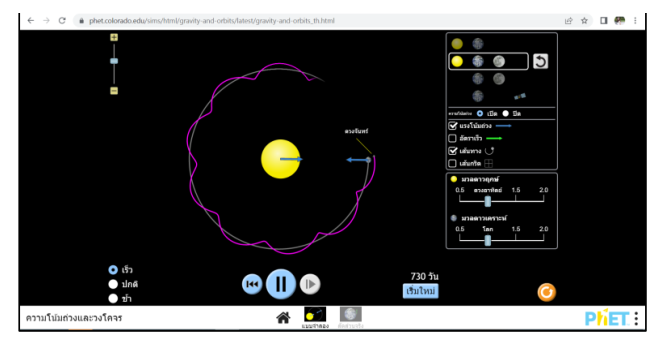The Development of Grade 9 Students’ Mental Models of Phenomena in the Solar System through Model-based Learning with Interactive Simulation
DOI:
https://doi.org/10.14456/psruhss.2024.25Keywords:
Mental model, Scientific model, Solar system, Model-based learning, Interactive simulationAbstract
Preparing students to create and use models is crucial to learning science because scientists use models to test, predict, and explain natural phenomena and scientific knowledge. Therefore, this classroom action research aims to develop mental models for grade 9 students on phenomena caused by the interaction between the sun, the earth, and the moon by using model-based learning in conjunction with interactive simulation. The participants consisted of 36 grade 9 students from a large public all-girls secondary school in Bangkok. Data obtained from an open-ended mental model test. Students’ responses were analyzed via a content analysis method by grouping the responses into five categories. The results of the research indicated that after learning with model-based learning in combination with interactive simulation, most students (37.78%) were in the Partial consistent mental model category. There were 28.89% of children who had a Consistent mental model with scientific model (CM). And the majority of students were in the CM category on the topic of seasons.
References
กระทรวงศึกษาธิการ. (2560). มาตรฐานการเรียนรู้และตัวชี้วัด กลุ่มสาระการเรียนรู้คณิตศาสตร์ วิทยาศาสตร์ และสาระภูมิศาสตร์ ในกลุ่มสาระการเรียนรู้สังคมศึกษา ศาสนา และวัฒนธรรม (ฉบับปรับปรุง พ.ศ. 2560) ตามหลักสูตรแกนกลางการศึกษาขั้นพื้นฐานพุทธศักราช 2551. กรุงเทพฯ: ชุมนุมสหกรณ์การเกษตรแห่งประเทศไทย.
กฤษณา โภคพันธ์. (2554). การพัฒนาแนวคิดเรื่องดาราศาสตร์และอวกาศ และเจตคติทางวิทยาศาสตร์ของนักเรียนระดับชั้นมัธยมศึกษาปีที่ 5 ด้วยกิจกรรมการเรียนรู้โดยใช้แบบจำลองเป็นฐาน (วิทยานิพนธ์ปริญญามหาบัณฑิต). กรุงเทพฯ: มหาวิทยาลัยเกษตรศาสตร์.
ณัชธฤต เกื้อทาน. (2557). การพัฒนาแบบจำลองทางความคิดเรื่องพันธะเคมีของนักเรียนชั้นมัธยมศึกษาปีที่ 4
ด้วยกิจกรรมการเรียนรู้โดยใช้แบบจำลองเป็นฐาน (วิทยานิพนธ์ปริญญามหาบัณฑิต). กรุงเทพฯ: มหาวิทยาลัยเกษตรศาสตร์.
ณัฐพล กวดไทย. (2563). การพัฒนาความสามารถในการสร้างแบบจำลองของนักเรียนชั้นมัธยมศึกษาปีที่ 4 รายวิชาชีววิทยาด้วยการจัดการเรียนรู้โดยใช้แบบจำลองเป็นฐาน (วิทยานิพนธ์ปริญญามหาบัณฑิต). มหาสารคาม: มหาวิทยาลัยมหาสารคาม.
ทิศนา แขมมณี. (2550). การสอนจิตวิทยาการเรียนรู้เรื่องศาสตร์การสอนองค์ความรู้เพื่อการจัดกระบวนการเรียนรู้ที่มีประสิทธิภาพสูง. กรุงเทพฯ: จุฬาลงกรณ์มหาวิทยาลัย.
ธีรตา ชาติวรรณ. (2561). การจัดการเรียนรู้โดยใช้แบบจำลองเป็นฐานร่วมกับเทคโนโลยีเสมือนจริงเพื่อพัฒนาแบบจำลองทางความคิดของนักเรียนชั้นมัธยมศึกษาปีที่ 4 เรื่องพันธะโควาเลนต์ (วิทยานิพนธ์ปริญญามหาบัณฑิต). พิษณุโลก: มหาวิทยาลัยนเรศวร.
นันทิตา ขันทอง. (2562). การพัฒนาแอปพลิเคชันเทคโนโลยีความจริงเสมือนสำหรับการเรียนรู้ เรื่อง ธาตุและ สารประกอบเคมี (วิทยานิพนธ์ปริญญามหาบัณฑิต). พิษณุโลก: มหาวิทยาลัยนเรศวร.
ภรทิพย์ สุภัทรชัยวงศ์. (2556). การจัดกิจกรรมการเรียนรู้โดยใช้แบบจำลองเป็นฐานเพื่อพัฒนาแบบจำลองทาง ความคิด เรื่อง โครงสร้างอะตอมและความเข้าใจธรรมชาติแบบจำลองของนักเรียนชั้นมัธยมศึกษาปีที่ 4 (วิทยานิพนธ์ปริญญามหาบัณฑิต). กรุงเทพฯ: มหาวิทยาลัยเกษตรศาสตร์.
วริษฐา รัตนพันธุ์จักร. (2561). การพัฒนาแบบจำลองทางความคิดเรื่องยีนและโครโมโซมของนักเรียนชั้นมัธยมศึกษาปีที่หกโดยการจัดการเรียนรู้โดยใช้แบบจำลองเป็นฐาน (วิทยานิพนธ์ปริญญามหาบัณฑิต). กรุงเทพฯ: มหาวิทยาลัยเกษตรศาสตร์.
วีระยุทธ คำดี. (2561). การพัฒนาแนวคิดของนักเรียนชั้นมัธยมศึกษาปีที่ 4 เรื่อง โครโมโซมและการแบ่งเซลล์ด้วยการจัดการเรียนรู้โดยใช้แบบจำลองเป็นฐานร่วมกับการใช้สื่อมัลติมีเดีย (วิทยานิพนธ์ปริญญามหาบัณฑิต). กรุงเทพฯ: มหาวิทยาลัยเกษตรศาสตร์.
ศุภกาญจน์ รัตนกร. (2552). การศึกษาแบบจำลองทางความคิดและความเข้าใจธรรมชาติของแบบจำลองของนักเรียนระดับชั้นมัธยมศึกษาปีที่ 5 เรื่อง กรดเบส (วิทยานิพนธ์ปริญญามหาบัณฑิต). กรุงเทพฯ: มหาวิทยาลัยเกษตรศาสตร์.
สถาบันส่งเสริมการสอนวิทยาศาสตร์และเทคโนโลยี (สสวท.). (2560). หนังสือเรียนรายวิชาวิทยาศาสตร์พื้นฐานชั้นมัธยมศึกษาปีที่ 3 วิทยาศาสตร์และเทคโนโลยี เล่ม 1 ตามมาตรฐานการเรียนรู้และตัวชี้วัดกลุ่มสาระการเรียนรู้วิทยาศาสตร์และเทคโนโลยี (ฉบับปรับปรุง พ.ศ. 2560) ตามหลักสูตรแกนกลางการศึกษาขั้นพื้นฐานพุทธศักราช 2551. กรุงเทพฯ: โรงพิมพ์คุรุสภาลาดพร้าว.
สราวุธ แท่นจินดารัตน์. (2559). การพัฒนาแบบจำลองทางความคิด เรื่องพันธะโคเวเลนต์ และความเข้าใจเกี่ยวกับธรรมชาติของแบบจำลองของนักเรียนชั้นมัธยมศึกษาปีที่ 4 โดยการจัดการเรียนรู้แบบสืบเสาะหาความรู้ที่ใช้แบบจำลองเป็นฐาน (วิทยานิพนธ์ปริญญามหาบัณฑิต). กรุงเทพฯ: มหาวิทยาลัยเกษตรศาสตร์.
ฮามีต๊ะ มูสอ. (2555). การพัฒนาแบบจำลองทางความคิด เรื่องกรด-เบส ของนักเรียนชั้นมัธยมศึกษาปีที่ 5 ด้วยกิจกรรมการเรียนรู้โดยใช้แบบจำลองเป็นฐาน (วิทยานิพนธ์ปริญญามหาบัณฑิต). กรุงเทพฯ: มหาวิทยาลัยเกษตรศาสตร์.
Chi, M. T. H., & Roscoe, R. D. (2002). The process and challenges of conceptual change. In M. Limón & L. Mason (Eds.). Reconsidering Conceptual Change: Issues in Theory and Practice (pp. 3–27). Kluwer Academic Publishers.
Dede, C. (2009). Immersive Interfaces for Engagement and Learning. Science, 323, 66-69.
Giere, R. N. (1998). Explaining Science: A Cognitive Approach. Chicago: University of Chicago Press.
Gilbert, J. K. (2005). Visualization in Science Education. Netherlands: Springer.
Gilbert, S. W., & Ireton, S. W. (2003). Understanding Models in Earth and Space Science. Arlington, VA: NSTA Press.
Gobert, J. D., & Buckley, B. C. (2000). Introduction to model-based teaching and learning in science education. International Journal of Science Education, 22(9), 891-894. https://doi.org/10.1080/095006900416957
Hilgard, E. R. (1962). Impulsive versus realistic thinking: An examination of the distinction between primary and secondary processes in thought. Psychological Bulletin, 59, 477-488.
Inoue, N. (2015). Beyond Actions: Psychology of Action Research for Mindful Educational Improvement. New York: Peter Publishing.
Johnson-Laird, P. N. (1983). Mental Models: Towards a Cognitive Science of Language, Inference, and Consciousness. Cambridge, MA: Harvard University Press.
Kemmis, S., McTaggart, R., & Nixon, R. (2014). The Action Research Planner: Doing Critical Participatory Action Research. Singapore: Springer.
NASA Goddard. (2011). Moon Phase and Libration. Retrieved June 10, 2022, from https://www.youtube.com/watch?v=3f_21N3wcX8&t=2s
National Research Council. (2012). Science for All Americans. New York: Oxford University Press.
Norman, D. N. (1983). Some observations on mental models. In D. Gentner & A. L. Stevens (Eds.), Mental models (pp. 7-14). New Jersey: Lawrence Erlbaum Associates.
Phet Interactive Simulations. (2002). ความโน้มถ่วงและวงโคจร. Retrieved May 25, 2022, from https://phet.colorado.edu/sims/html/gravity-and-orbits/latest/gravity-and-orbits_th.html
Sotiriou, S., & Bogner, F. X. (2008). Visualizing the invisible: Augmented reality as an innovative science education scheme. Journal of Computational and Theoretical Nanoscience, 1(1), 114-122.

Downloads
Published
How to Cite
Issue
Section
License
Copyright (c) 2024 Humanities and Social Sciences Journal of Pibulsongkram Rajabhat University

This work is licensed under a Creative Commons Attribution-NonCommercial-NoDerivatives 4.0 International License.
Any articles or comments appearing in the Journal of Humanities and Social Sciences, Rajabhat Phibulsongkram University, are the intellectual property of the authors, and do not necessarily reflect the views of the editorial board. Published articles are copyrighted by the Journal of Humanities and Social Sciences, Rajabhat Phibulsongkram University.








